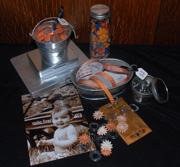Organizing Your Scrapbooking Stock
There are several ways in which to organize your store, with pros and cons to each method. Generally, you can sort your product by: product type, theme and manufacturer or “boutique-style.â€
Many stores organize their stock by product type. All the patterned paper is together, all the eyelets are in one place, the adhesives are together and so on. This is helpful to customers who have a good idea what they’re looking for. You’ll be able to tell which shoppers are hooked on chalk inks, metal charms or plastic letters, because they’ll make a beeline to that part of the store. The main drawback to this approach is that, in order to keep like product with like, you’ll end up separating products that were intended to go together. Scrapbookers may be frustrated when they complete a page using Heidi Swapp flowers only to learn that the coordinating chipboard pieces were at the other end of the store and they missed them. Some shops get around this problem—at least at first—by displaying new products together on a table or other highly visible area before “filing†it on the shelves and racks by type.
Plenty of customers, however, prefer to see products grouped together by theme or even manufacturer. With this method, for example, Halloween-themed patterned paper, dimensional stickers, brads, cardstock letters and so on would all be found within the same few square feet of shelf area. This approach makes things easy for the shopper who is just popping in to grab supplies for a baby-themed page, or who wants to check out the latest Doodlebug paper and coordinating embellishments. It’s also a fun way to greet customers and drive sales by setting up in-season items closest to the door or register.
Increasingly popular is the “boutique†style scrapbook store, in which embellishments are artfully arranged in appealing displays. For example: tiny tin pails overflowing with colorful buttons, watchmakers’ cases full of brads and a spice rack containing beautiful ribbons–all upon an antique desk, vintage stepstool or similar piece of furniture that’s a far cry from sterile metal, wire or particle board shelves. This approach is high on visual appeal, but there are a couple of drawbacks: It will take time, and most importantly, space. All that cuteness takes up room that could be used to stock more product. As your business grows, you will want to leave room for adding product, rather than being locked into a cute-yet-impractical store setup. The decision is yours, and a lot depends on your market. Be sure to read the section, “Knowing Your Market.â€
It’s important for you to expect your store to grow in size as your clientele and popularity grows. You may have, for budget or location reasons, started with a store that’s relatively small in terms of square footage. For better or for worse, you may end up being one of those stores that relocates more than once to achieve more floor space. At any rate, try not to let your store get too cluttered or jam-packed with product. Not only will it be hard for customers to find things; you may be in violation of Americans with Disabilities Act rules regarding aisle width and other issues. And here’s an insider tip: Scrapbook stores that don’t have “kid areas†probably don’t dislike children; they just can’t spare precious floor space.
Be sure to purge old stock regularly by putting it on sale, or placing it in a sale area. It’s probably taking up space that could be used to better-highlight new product, or maybe it’s just making your store look dated.
